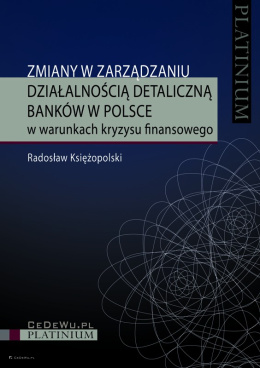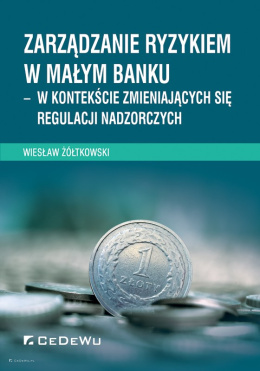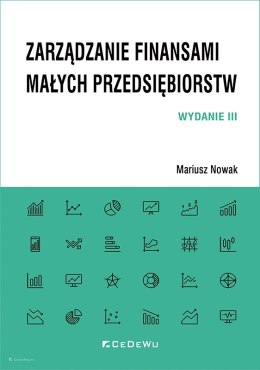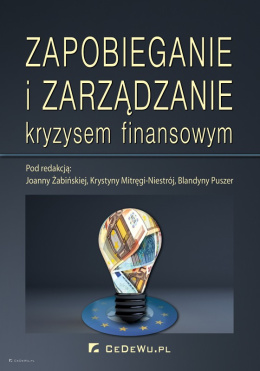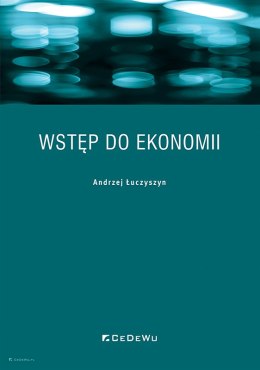-
Shopping cart is empty
-
x

-
Shopping cart is empty
-
x
- Categories
-
Pochodne instrumenty kredytowe. Systematyka, wycena, zastosowanie. Struktury standardowe i egzotyczne (wyd. III)
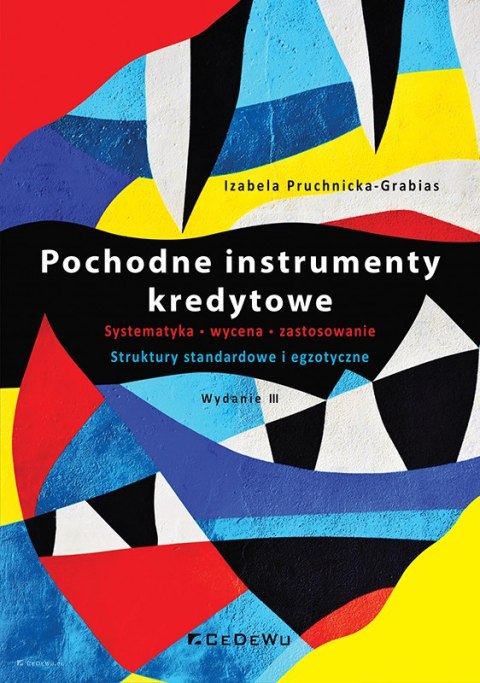
Monografia, posiadająca istotne walory praktyczne, jest pierwszą pozycją polskiej autorki w tak kompleksowy sposób analizującą nie tylko istotę funkcjonowania kredytowych instrumentów pochodnych, ale również modele ich wyceny, doskonalenie których autorka słusznie uznaje za kluczowe dla rozwoju tego rynku. Niewątpliwą zaletą opracowania jest mnogość przykładów, przeprowadzających Czytelnika przez kolejne etapy szacowania wartości omawianych struktur i tworzących idealną bazę dla zrozumienia konstrukcji tych złożonych produktów. Prof. zw. dr hab. Janusz Soboń Publikacja stanowi cenne kompendium wiedzy zarówno dla praktyków rynku finansowego, jak i studentów oraz słuchaczy studiów podyplomowych i doktoranckich, jak również dla pracowników nauki zainteresowanych wdrażaniem metod kwantyfikacji ryzyka kredytowego w praktykę. Prof. nadzw. SGH dr hab. Paweł Niedziółka
| Shipping within | 24 hours |
| The bar code | |
| ISBN | 978-83-8102-590-4 |
| EAN | 9788381025904 |
Prof. zw. dr hab. Janusz Soboń
Publikacja stanowi cenne kompendium wiedzy zarówno dla praktyków rynku finansowego, jak i studentów oraz słuchaczy studiów podyplomowych i doktoranckich, jak również dla pracowników nauki zainteresowanych wdrażaniem metod kwantyfikacji ryzyka kredytowego w praktykę.
Prof. nadzw. SGH dr hab. Paweł Niedziółka
Wprowadzenie 9
Rozdział 1
Istota pochodnych instrumentów kredytowych i ich klasyfikacja 11
1.1. Definicje zawarte w literaturze oraz przesłanki zastosowania 11
1.2. Przesłanki zastosowania 16
1.3. Uczestnicy rynku kredytowych instrumentów pochodnych 25
1.4. Systematyka instrumentów klasycznych i niestandardowych 29
Rozdział 2
Instrumenty pierwszej generacji 33
2.1. Swapy kredytowe (credit default swaps) 34
2.2. Indeksy swapów kredytowych 36
2.3. Swapy dochodowe (total return swaps) 42
2.4. Opcje na spread kredytowy (credit spread options) 43
2.5. Pozostałe odmiany klasyczne 45
Rozdział 3
Instrumenty drugiej generacji 47
3.1. Instrumenty egzotyczne - wprowadzenie 47
3.1.1. Instrumenty typu swap 47
3.1.1.1. Kredytowy swap koszykowy 48
3.1.1.2. Wycena koszykowego swapu typu first-to-default 51
3.1.1.3. Zabezpieczenie krótkiej pozycji w koszykowym swapie typu first-to-default 53
3.1.1.4. Inne rodzaje swapów koszykowych 55
3.1.1.5. Inne rodzaje swapów kredytowych 56
3.1.1.6. Struktury oparte na stopie odzysku 66
3.1.2. Instrumenty typu opcja 68
3.1.2.1. Niestandardowe odmiany opcji kredytowych 68
3.1.2.2. Opcje na spread (spread options) 70
3.1.2.3. Opcje substytucyjne 71
3.2. Konstrukcje strukturyzowane (syntetyczne) 71
3.2.1. Ogólne założenia dotyczące budowy instrumentów oraz ich klasyfikacja 71
3.2.2. CDO (collateralized debt obligation) 73
3.2.3. CLN (credit linked notes) 77
3.2.4. Egzotyczne odmiany bonów kredytowych 87
3.2.5. Swapcje kredytowe (credit swaptions) 88
3.2.6. Najnowsze innowacje na rynku pochodnych instrumentów kredytowych 91
Rozdział 4
Wycena kredytowych instrumentów pochodnych na przykładzie swapów kredytowych 93
4.1. Techniki wyceny swapów kredytowych 93
4.2. Najprostszy model wyceny swapu kredytowego i jego ograniczenia 96
4.3. Modele oparte na ryzyku niewypłacalności 97
4.4. Wycena swapu kredytowego oparta o ryzykowną pożyczkę 99
4.5. Wycena swapu kredytowego z ryzykiem kontrahenta 100
4.6. Dekompozycja spreadów swapów kredytowych 101
4.7. Wycena swapu kredytowego w podejściu strukturalnym 102
4.8. Wycena swapu kredytowego w odniesieniu do wartości rynkowej (MTM) 106
4.9. Wycena koszykowych swapów kredytowych 107
4.10. Wycena swapów portfelowych 112
4.11. Symulacja Monte Carlo w wycenie swapów kredytowych 113
4.12. Wycena oparta na spreadzie kredytowym 116
4.13. Przykład zabezpieczenia pozycji w swapie kredytowym z punktu widzenia dealera 118
Rozdział 5
Modele wyceny ryzyka kredytowego 121
5.1. Istota ryzyka kredytowego 121
5.2. Klasyfikacja modeli ryzyka kredytowego 127
5.3. Pierwotne metodologie wyceny ryzyka kredytowego 131
5.3.1. Krytyczna ocena, analiza dyskryminacyjna oraz analiza roszczeń warunkowych - mocne i słabe strony 131
5.3.2. Model Altmana jako najbardziej znany przykad modelu scoringowego 132
5.4. Tradycyjne metody wyceny 134
5.4.1. Ogólna struktura modelu ryzyka kredytowego 134
5.4.2. Modele strukturalne i ich założenia 135
5.4.3. Metodologie wyceny ryzyka kredytowego CDO stosowane przez największe światowe agencje ratingowe 140
5.4.3.1. Istota metody ekspansji dwumianowej (BET) 142
5.4.3.2. Symulacja Monte Carlo i jej etapy 144
5.4.4. Modelowanie czasu wystąpienia niewypłacalności 146
5.4.5. Problem korelacji pomiędzy zdarzeniami niewypłacalności 147
5.4.6. Inne metody kwantyfikacji prawdopodobieństwa występowania zdarzeń nietypowych 152
5.5. Skrócone modele wyceny oparte na niewypłacalności 154
5.5.1. Modele Jarrowa, Lando i Turnbulla (JLT) 155
5.5.2. Model Dasa-Tufano 156
5.5.3. Model Duffie-Singletona 156
5.6. Modele ryzyka kredytowego oparte na stopie odzysku 158
5.6.1. Cechy charakterystyczne metody Credit Risk +, CreditMetrics oraz KMV 158
5.6.2. Credit Risk + i jej zastosowanie 162
5.6.3. Aplikacja metody CreditMetrics 168
5.6.4. Rozkład wartości dla portfela zawierającego więcej niż dwie obligacje 173
5.7. Inne miary przydatne w analizie ryzyka kredytowego 180
5.7.1. Wielkość oczekiwanej straty kredytowej (EDL) 180
5.7.2. Odchylenie standardowe stóp zwrotu 181
5.7.3. Inne modele pomiaru zmienności czynników ryzyka 183
5.7.4. Współczynnik korelacji 185
5.7.5. Wartość narażona na ryzyko (VaR) 185
5.7.5.1. Metody szacowania VaR oraz ich słabe i mocne strony 185
5.7.5.2. Kalkulacja wartości narażonej na ryzyko dla pojedynczej pozycji 188
5.7.5.3. Wartość narażona na ryzyko dla portfela aktywów - przykłady obliczeń 190
5.7.5.4. VaR w analizie ryzyka kredytowego (Credit VaR) 197
5.7.6. Spready kredytowe i ich znaczenie w wycenie ryzyka kredytowego 198
Dodatek 5.1. Podstawowe modele procesów stochastycznych 208
Dodatek 5.2. Działania na zbiorach 210
Dodatek 5.3. Cechy charakterystyczne rozkładu normalnego 211
Rozdział 6
Rynek kredytowych instrumentów pochodnych 213
6.1. Struktura rynku w latach poprzedzających kryzys finansowy 2007-2009 213
6.2. Pochodne kredytowe na tle pozostałych instrumentów pochodnych w latach 1999-2010 221
6.3. Systemy ratingowe w największych agencjach ratingowych 225
6.3.1. Ratingi emisji 225
6.3.2. Ratingi emitenta 233
6.3.3. Ratingi wewnętrzne 237
6.3.4. Dylematy towarzyszące nadawaniu ratingów 238
6.4. Czynniki ryzyka związane z pochodnymi instrumentami kredytowymi 242
6.5. Ryzyko związane z zawieraniem transakcji przy użyciu opcji kredytowych 248
6.6. Problemy towarzyszące stosowaniu kredytowych instrumentów pochodnych 253
Załącznik 1
Tablice dystrybuanty standardowego rozkładu normalnego dla argumentów ł 0 265
Załącznik 2
Tablice dystrybuanty standardowego rozkładu normalnego dla argumentów Ł 0 266
Bibliografia 267
Dr hab. Izabela Pruchnicka-Grabias - prof. SGH, zatrudniona w Instytucie Bankowości Szkoły Głównej Handlowej w Warszawie, gdzie pełni funkcję Kierownika Zakładu Bankowości Inwestycyjnej. Zagadnienia związane z inwestycjami alternatywnymi wykłada także na Northeastern Illinois University w Chicago. Ekspert w dziedzinie zarządzania ryzykiem finansowym. Autorka ekspertyz przygotowywanych na zlecenie takich instytucji jak m.in. Biuro Analiz Sejmowych, Kancelaria Prezydenta RP, Komisja Europejska, Sąd Okręgowy w Warszawie, Sąd Okręgowy we Wrocławiu, a także ponad 150 publikacji dotyczących rynku finansowego, w tym wielu wydanych za granicą.
Recenzenci:
Prof. nadzw. SGH dr hab. Paweł Niedziółka
Prof. zw. dr hab. Janusz Sobon
Allen M., M. Rodrigues, Boost your ratings, A Suppllement to Risk Magazine, lipiec 1997.
Altman E., B. Brady, A. Resti, A. Sironi, The link between default and recovery rates: theory, empirical evidence and implications, Working paper 2003.
Altman E., B. Brooks, A. Resti, A. Sironi, The link between default and recovery rates: theory, empirical evidence and implications, 2003, available at: www.defaultrisk.com
Altman E., Financial Ratios, Discriminant Analysis and the Prediction of Corporate Bankruptcy, Journal of Finance, No. 23.
Amato J.D., J. Gyntelberg, CDS index tranches and the pricing of credit risk correlations, BIS Quarterly Review, marzec 2005.
Andrew C., M. Haubenstock, J. Vinci, Active Portfolio Credit Risk Management, 2000, s. 6, www.creditex.com
Banks E., M. Glantz, P. Siegel, Credit derivatives. Techniques to Manage Credit Risk for Financial Professionals, McGraw-Hill, Nowy Jork 2007.
Basel Committee on Banking Supervision, The new Basel Capital Accord, kwiecień 2003.
BBA Credit Derivatives Report 1997/1998, British Bankers" Association 1998.
Beder T.S., F. Lacono, The good, the bad - and the ugly, A Supplement to Risk Magazine, lipiec 1997.
Beinstein E. i in., Credit Derivatives Handbook, Detailing Credit Default Swap Products, markets and trading strategies, J.P. Morgan, Nowy Jork-Londyn, grudzień 2006.
Bernett-Hart A.K., The Story of the CDO Market Meltdown: An Empirical Analysis Harvard College, Cambridge, Massachusetts, 19 marca 2009.
Best P., Wartość narażona na ryzyko. Obliczanie i wdrażanie modelu VaR, Dom Wydawniczy ABC, Kraków 2000.
Black F., M.S. Scholes, The Pricing of Options and Corporate Liabilities, Journal of Political Economy, 1973, Vol. 81.
Bodie Z., A. Kane, A.J. Marcus, Investments, Irwin/McGraw-Hill, Nowy Jork 2001.
Bomfim A.N., Understanding Credit Derivatives and Related Instruments, Elsevier Academic Press, Londyn 2005.
British Bankers Association Credit Derivatives Report 2006.
Bund S., M. Neugebauer, K. Gill, R. Hrvatin, J. Zelter, J. Schiavetta, Global Rating Criteria for Collateralised Debt Obligations, Fitch Ratings, sierpień 2003.
Butler C., Tajniki Value at Risk. Praktyczny podręcznik zastosowań metody VaR, LIBER, Warszawa 2001.
Cameron M., The essential ABS, Risk, wrzesień 2010.
Campbell A., States of flux, Risk, wrzesień 2010.
Campbell J., G. Taksler, Equity volatility and corporate bond yields, Journal of Finance 58 (6), grudzień 2003.
Carty L.V., J.S. Fons, Measuring Changes in Corporate Credit Quality, Moody's Special Report, listopad 1993.
Chacko G., A. Sjoeman, H. Motohashi, V. Dessain, Credit Derivatives. A Primer on Credit Risk, Modelling, and Instruments, Wharton University of Pensylvania, New Jersey 2006.
Chaplin G., Credit Derivatives. Risk Management, Trading & Investing, John Wiley & Sons, Ltd, West Sussex 2005.
Chaplin G., The Credit Balance, Financial Products Issue, No. 78, s. 12-13.
Choforas D.N., Credit Derivatives and the Management of Risk Including Models for Credit Risk, Nowy Jork Institute of Finance, Nowy Jork 2000.
Choforas D.N., Wealth Management. Private Banking, Investment Decisions and Structured Financial Products, ELSEVIER, Oksford 2006.
Choudhry M., Credit Derivatives and Synthetic Securitisation, John Wiley & Sons, Inc., USA 2001.
Choudhry M., Structured Credit Productss. Credit Derivatives & Synthetic Securitisation, John Wiley & Sons, Ltd., Singapur 2004.
Choudhry M., The Bond and Money Markets: Strategy, Trading, Analysis, Butterworth-Heinemann, Oksford 2003.
Chriss N.A., Black-Scholes and beyond: option pricing models, McGraw-Hill Book Company, Nowy Jork 1997.
Cifuentes A., G. O'Connor, The Double Binomial Method and Its Application to s Special Case of CBO Structures, Moody's Investors Service Structured Finance Special Report, grudzień 1996.
Clark J., European CDS dealers ready for start of central clearing, Risk, sierpień 2009.
Clark J., European credit default swap clearing off to a steady start, Risk, wrzesień 2009.
Collin-Dufresne P., R. Goldstein, J. Martin, The determinants of credit spread changes, Journal of Finance 56 (6), grudzień 2001.
Cox P.R., M.C. Freeman, B. Wright, The impast of Credit Derivatives on Non-Financial Corporations, University of Exeter, Paper No. 04/12.
Crabbe M., Central banks seek more data on credit derivatives, Risk, czerwiec 2004.
Credit Default Swaps and Counterparty Risk, European Central Bank, sierpień 2009.
Credit Derivative Handbook 2003. A Guide to Products, Valuation, Strategies and Risks, Merrill Lynch, 16 kwiecień 2003.
Credit derivatives exceed global derivatives credit risk, Chicago, 31 maj 2005, www.expertclick.com, 20.10.2006.
Credit derivatives market had priced Enron collapse long before it was public, www.credit-deriv.com, 20.04.2006.
Credit Derivatives Report prepared by the Derivatives Working Party of the Faculty & Institute of Actuaries, 2004.
Credit Derivatives, Goldman Sachs, październik 2009, s. 12, http://www2.goldmansachs.com/our-firm/on-the-issues/viewpoint/viewpoint-articles/state-of-the-market-cds-101.pdf
Credit Risk and the Emergence of Credit Derivatives, 8 listopad 2005.
Credit Risk Modelling: Current Practices and Applications, Basel Committee on Banking Supervision, Basel, kwiecień 1999.
CreditRisk+, A Credit Risk Management Framework, Credit Suisse First Boston, 1997.
Crouhy M., D. Galai, R. Mark, Risk management, McGraw-Hill, Nowy Jork 2001.
Dages B.G., D. Palmer, S. Tunery, An Overview of the emerging market credit derivatives market, Federal Reserve Bank of Nowy Jork, maj 2005, www.bis.org, 15.02.2006.
Dane pochodzące z: Depository Trust & Clearing Corporation - Trade Information Warehouse, 2010.
Das S., Credit Crash? 2007, s. 18, www.ibbm.org.my.pdf
Das S., Credit Derivatives and Credit Linked Notes, John Wiley & Sons, Singapur 2000.
Das S., Credit Derivatives. CDOs & Structured Credit Products, John Wiley & Sons (Asia) Pte Ltd, Singapur 2005.
Das S., P. Tufano, Picing Credit Sensitive Debt when Interest Rate, Credit Ratings and Credit Spreads Are Stochastic, Journal of Financial Engineering, 1996.
Das S., Swaps and Financial Derivatives Library, Derivative Products & Pricing, 3rd Edition, John Wiley and Sons, Singapur 2005.
Das S., Tales of leverage, Risk, lipiec 2009.
Das S., Traders, Guns & Money, FT Prentice Hall 2006.
Davidson C., Clear benefits, Risk, marzec 2009.
Davidson C., The challenges of central clearing, Risk, wrzesień 2010.
Davies M., D. Pugachevsky, Pricing and hedging credit default swaps on indices, Risk, styczeń 2004.
Definitions of Ratings and Other Forms of Opinion, Fitch Ratings, czerwiec 2010.
Deutsche Bundesbank, Credit Risk Transfer Instruments: Their Use by German Banks and Aspects of Financial Stability, Monthly Report, kwiecień 2004.
Developing a Supervisory Approach to Credit Derivatives, Supervision and Surveillance, Discussion Paper, listopad 1996, Bank of England.
Deventer D. van, K. Imai, Credit Risk Models and the Basel Accords, John Wiley & Sons (Asia) Pte Ltd, Singapur 2003.
Duffie D., Innovations in Credit Risk Transfer: Implications for Financial Stability, Draft: lipiec 2, 2007.
Duffie D., K. Singleton, Modelling Term Structures of Defaultable Bonds, Review of Financial Studies 1997.
Elton E., M. Gruber, D. Agrawal, C. Mann, Explaining the rate spread on corporate bonds, Journal of Finance 56 (1), luty 2001.
Ericsson J., K. Jacobs, R. Oviedo, The determinants of credit default premia, Journal of Financial and Quantative Analysis 2007.
Fabozzi F.J., M. Choudhry, The Handbook of European Structured Financial Products, John Wiley & Sons, Inc., Hoboken 2004.
Fender, J. Kiff, CDO rating methodology: Some thoughts on model risk and its implications, BIS Working Papers No. 163, Monetary and Economic Department, listopad 2004.
Finnerty J.D., The PricewaterhouseCoopers Credit Derivatives Primer, Financial Advisory Services, 1999.
Fitch IBCA, Rating Criteria for Cash Flow Collateralized Debt Obligations, www.creditex.com, 01.07.2010.
Fitch Ratings, Moody's Investors Service, Standard & Poor's.
Francis Ch., A. Kakodkar oraz B. Martin, Credit Derivative Handbook, A Guide to Products, Valuation, Strategies and Risks, Merrill Lynch, 16 kwiecień 2003.
Gajewski K., Kontrakty swap w globalnych przepływach finansowych, dodatek do czasopisma Bank i Kredyt nr 5/2009.
Gallagher P., Credit Volatility Spurs Interest in Credit Default Swaptions Market, sierpień 2002, sierpień 2002, Risk s. 11 oraz N. Patel, Default Swaps: The Next Frontier, maj 2003, Risk.
Garcia J., S. Goossens, W. Schoutens, Let's jump together: pricing credit derivatives, Risk, wrzesień 2008.
Gątarek D., R. Maksymiuk, M. Krysiak, Ł. Witkowski, Nowoczesne metody zarządzania ryzykiem finansowym, Wig-Press, Warszawa 2001.
Giaccherini L. i G. Pepe, How secure are ratings? Risk, wrzesień 2008.
Giese G., The impact of PD/LGD correlations on credit risk capital, Risk, kwiecień 2005.
Głogowski A., Rola instrumentów pochodnych w kryzysie światowego systemu finansowego lat 2007-2009. Wybrane zagadnienia. Dodatek do czasopisma Bank i Kredyt, 1/2010, NBP.
Gordy M., A risk-factor model foundation for ratings-based bank capital rules, Journal of Financial Intermediation 12 (3).
Gore G., Green light for Indian CDSs, Risk, czerwiec 2007.
Gregory J., A free lunch and the credit crunch, Risk, sierpień 2008.
Gregory J., A trick of the credit tail, Risk, marzec 2008.
Grodzicki M., Kredytowe instrumenty pochodne w dobie kryzysu finansowego, dodatek do czasopisma Bank i Kredyt, 4/2009, NBP.
Gupton G.M., Ch.C. Finger, M. Bhatia, CreditMetrics - Technical Document, 1997.
Haws D., Plugging the gaps, Risk, marzec 2009.
Heyde F., U. Neyer, The Stability of the Banking Sector and Credit Default Swaps, Martin-Luther-University Halle-Wittenberg, Department of Economics, Update of Discussion Paper No. 51, luty 2007,
https://editorialexpress. com/cgibin/conference/download. cgi? db_name=res2008&paper_id=306
Hillebrand M., Modelling and estimating dependent loss given default, Risk, wrzesień 2006.
Horwood C., The credit derivatives divide, Risk, luty 2004.
Hull J., A. White, Valuing Credit Default Swaps II: Modeling Default Correlations, Journal of Derivatives, Spring 2001.
Hull J.C., Options, futures and other derivatives, fourth edition, Prentice-Hall International, Inc., Upper Saddle River 2000.
Instefjord N., Risk and hedging: do credit derivatives increase bank risk? Journal of Banking and Finance, vol. 29, iss. 2, luty 2005.
Interdealer rankings 2010, Risk, wrzesień 2010.
ISDA Credit Derivatives Definitions, 1999.
Jackowicz K., Pochodne instrumenty kredytowe (II), Bank i Kredyt, kwiecień 2001.
Jackowicz K., Pochodne instrumenty kredytwe (I). Definicja i rodzaje pochodnych instrumentów kredytowych, Bank i Kredyt nr 3/2001.
Jajuga K., Zarządzanie ryzykiem kredytowym, [w:] K. Jajuga (red.), Zarządzanie ryzykiem, Wydawnictwo Naukowe PWN, Warszawa 2007.
Jajuga K. (red.), Zarządzanie ryzykiem, Wydawnictwo Naukowe PWN, Warszawa 2007.
Jajuga K., Z. Krysiak (red.), Credit Risk of Mortgage Loans. Modelling and Management, Polish Bank Associaton, Warsaw 2005.
James J., Defining forex option value, Risk, styczeń 2003.
Jarrow R., Current advances in the modelling of credit risk, maj/czerwiec 1998, Journal of Derivatives Taxation & Regulation.
Jarrow R., D. Lando, A Markov model for the term structure of credit spreads, Review of Financial Studies, Volume 10, 1997.
Jarrow R., D. Lando, F. Yu, Default Risk and Diversification: Theory and Applications, working paper, Cornell University 1999.
Jarrow R., D. Madan, Arbitrage, Martingales and Private Monetary Value, Journal of Risk; R. Jarrow,
S. Turnbull, D. Turnbull, Derivative Securities, 2nd edition, South-Western College Publishing, Cincinnati, Ohio 2000.
Jarrow R., Default Parameter Estimation Using Market Prices, Financial Analysts Journal, wrzesień/październik 2001.
Jarrow R., L. Li, M. Mesler, D. van Devemter, The determinants of corporate credit spreads, Risk, wrzesień 2007.
Jarrow R., S. Turbull, Pricing Derivatives on Financial Securities Subject to Credit Risk, Journal of Finance, Nr 50 (1), 1995.
Jaworski L., Z. Zawadzka (red.), Bankowość, Poltext, Warszawa 2001.
Jeffery Ch., Credit model rethink, Risk, sierpień 2005.
Jeffery Ch., Derivatives disclosure: is Buffet right? Risk, kwiecień 2003.
Jorion P., Value at Risk: The New Benchmark for Managing Financial Risk, McGraw-Hill, Nowy Jork 2001.
Jóźwiak J., J. Podgórski, Statystyka od podstaw, Polskie Wydawnictwo Ekonomiczne, Warszawa 2000.
Jung J., Vexedd by variance, Risk, sierpień 2006.
Kasapi A. (tłum. N. Golec), Kredytowe instrumenty pochodne. Charakterystyka, rodzaje i zasady obrotu, Oficyna Wydawnicza, Kraków 2002.
Kealhofer S., Quantyfying credit risk I: default prediction, Financial Analyst Journal, styczeń/luty 2003.
Khasawneh R., Losses and lawsuits, Risk, maj 2008.
Kiff J., The Basic math of default-mode credit loss distrubutions, unpublished draft, Bank of Canada, Ottawa 2004.
Kothari V., Credit Derivatives and Synthetic Structures. A Guide to Commodisation of Credit Risk, Academy of Financial Services, Calcutta, lipiec 2002.
Krysiak Z., Ryzyko kredytowe a wartość firmy. Pomiar i modelowanie, Oficyna Ekonomiczna, Kraków 2006.
Krysicki W., L. Włodarski, Analiza matematyczna w zadaniach, część I, Wydawnictwo Naukowe PWN, Warszawa 1993.
Legal Studies Research Paper No. 07-74, http://ssrn.com/abstract=929747, 12.09.2010.
Li D. X., On Deffault Correlation: A Copula Function Approach, The RiskMetrics Group, Working paper number 99-07, kwiecień 2000.
Longstaff F., S. Mithal, E. Neis, Corporate yield spreads: default risk or liquidity? New evidence from the credit default swap market, Journal of Finance 60 (5), październik 2005.
Lucas D. J., Default Correlation and Credit Analysis, The Journal of Fixed Income, marzec 1995.
Luszniewicz A., T. Słaby, Statystyka z pakietem komputerowym StatisticaPl, C.H. Beck, Warszawa 2001.
Madigan P., Cornered on collateral, Risk, wrzesień 2010.
Madigan P., Keeping on top of the swaps, Risk, wrzesień 2010.
Madigan P., Rethinking CDSs, Risk, listopad 2008.
Markoff W.J., Simulation methods for risk analysis of collateralized debt obligations, [w:] S. Chick, P.J.
Sanchez, D. Ferrin, D.J. Morrice (eds.), Proceedings of the 2003 Winter Simulation Conference.
Martin R., Credit Spread shocks: how big and how often? Risk, sierpień 2009.
Martin R., H. Haworth, F. Koch, Struck off, Risk, listopad 2008.
Meissner G., Credit Derivatives, Application, Pricing, and Risk Management, Blackwell Publishing, Oksford 2005.
Merrit R., Linnell I., Grossman R., Shiavetta J. (18 lipiec 2005), Hedge Funds: An Emerging Force in Global Credit Markets; Fitch Ratings, Special Report, Nowy Jork.
Merton R.C., A Dynamic General Equilibrium Model of the Asset Market and Its Application to the Pricing of the Capital Structure of the Firm, 1970, unpublished manuscript available in R.C. Merton, Continuous-Time Finance, Blackwell Publishing, 1992.
Merton R.C., A Rational Theory of Option Pricing, Bell Journal of Economics and Management Science, Spring 1973.
Merton R.C., On the Pricing of Corporate Debt: the Risk Structure of Interest Rates, Journal of Finance, 1974, Vol. 29.
Merton R.C., On the Pricing of Corporate Debt: The Risk Structure if Interest Rated, Journal of Finance, czerwiec 1974.
Miller M.H., Financial innovation: The last twenty years and the next, Journal of Financial and Quantitative Analysis 1986, No. 21 (4).
Moody's Investors Service, Recovery rates and defaulted corporate bonds and preferred stocks, 1982-2003, 2003.
Navroz P., Default Swaps: the Next Frontier, Risk, maj 2003.
Neftci S., Fx Short Positions, Balance Sheets and Financial Turbulence: An Interpretation, Working Paper, 1998-18, Schwartz Center for Economic Policy Analysis (SCEPA), Nowy Jork.
Niedziółka P., Kredytowe instrumenty pochodne a stabilność finansowa, Szkoła Główna Handlowa w Warszawie, Warszawa 2009.
Nowakowski J., Ryzyko kredytowe jako suma błędów pierwszego i drugiego rodzaju, [w:] J. Nowakowski, J. Ostaszewski (red.), Wybrane zagadnienia teorii oraz praktyki finansów, Monografie i opracowania naukowe, Szkoła Główna Handlowa w Warszawie - Oficyna Wydawnicza, Warszawa 2005.
O'Kane D., M. Naldi, S. Ganapati, A. Berd, C. Pedersen, L. Schloegl, R. Marhal, The Lehman Brothers guide to exotic derivatives, The Lehman Brothers 2003.
O'Kane D., S. Saurav, Up-front Credit Default Swaps, Quantative Credit Research, Lehman Brothers, sierpień 2003.
OCC's Quarterly Report on Bank Trading and Derivatives Activities Fourth Quarter 2009, Administrator of National Banks, Washington DC 20219, kwiecień 2010 http://www.occ.treas.gov/deriv/deriv.htm
Ostas J., Derywaty kredytowe, Certyfikowane Seminarium GBI Partners, Warszawa, 23-24.02.2004.
Paganucci J., Credit Derivative Strategies, UBS Marketing Brochure, 1996.
Partnoy F., D.A. Skeel, Jr., The Promise and Perils of Credit Derivatives, Public Law and Legal Theory, University of Pennsylvania Law School, Research Paper No. 06-36, Institute for Law & Economics
University of Pennsylvania Law School Research Paper No. 06-22, University of San Diego School of Law.
Patel N.F., Flow business booms, Risk, luty 2003.
Patel N.F., New type of CDS gets off the ground, Risk, kwiecień 2004.
Patel N.F. Haddow-Allen, Rating agencies debunk credit derivatives misconceptions, Risk, styczeń 2004.
Pengelly M., Credit derivatives disappoint, Risk, lipiec 2007.
Pengelly M., Remake/remodel, Risk, sierpień 2009.
Pengelly M., The wrong market for credit derivatives, Risk, czerwiec 2007.
Pengelly N., Clear focus, Risk, sierpień 2010.
Pruchnicka-Grabias I., Egzotyczne opcje finansowe. Systematyka, wycena, strategie, CeDeWu, Wydanie III zmienione, Warszawa 2010.
Pruchnicka-Grabias I., Ochrona portfela obligacji przed ryzykiem stopy procentowej, Bank i Kredyt Nr nr 8/2004.
Rachel W., Recovery Swaps Hit Europe, Risk, sierpień 2004.
Report on the Role and Function of Credit Rating Agencies In the Operation of the Securities Markets, U.S. Securities and Exchange Commission, styczeń 2003.
Reyfman A., K. Toft, Credit derivatives - a risk management tool for non-bank corporations, Risk, marzec 2001 oraz Credit Risk Transfer, Committee on the Global Financial System, BIS, styczeń 2003.
Rosenberg J., A. Bhardwaj, M. Cho, M. Contopoulos, H. Mikkelsen, O. Radakovic, G. Taksler, Credit Market Strategist, Bank of America, grudzień 17, 2008.
Sanchez F., R. Ordovas, E. Martinez, M. Vega, Uncovering Pd/LGD liaisons, Risk, styczeń 2008.
Saunders A., Credit risk measurement, John Wiley & Sons 1999
Saunders A., L. Allen, Credit Risk Measurement. New Approaches to Value at Risk nad Other Paradigms, Second Edition, John Wiley & Sons, Nowy Jork 2002.
Sawyer N., Credit variance swaps surface, Risk, marzec 2006.
Schenk C., Landesbanken to offer credit loss database to third parties, Risk, kwiecień 2003.
Schoutens W., Levy process In finance, Wiley, Nowy Jork 2003.
Schroeck G., Risk management and vaue creation in financial institutions, John Wiley & Sons, Nowy Jork 2002.
Schubert D., Credit solution, Risk, luty 2009, s. 78-81.
Schulte-Herbrueggen W., G. Becker, From Basel II to Basel III, Risk, styczeń 2005.
Smithson C.W., C.W. Smith Jr, D.S. Wilford, Zarządzanie ryzykiem finansowym, Dom Wydawniczy ABC, Kraków 2000.
Smithson Ch., CDS risks, Risk, marzec 2009.
Smithson Ch., Credit derivatives (2), Risk, Vol. 9, No. 6, czerwiec 1996.
Smithson Ch., New dawn for loan portfolio management, Risk, styczeń 2003.
Sobczyk M., Statystyka, Wydawnictwo UMCS, Lublin 2000.
Soros G. nakłania rządy do zakazu stosowania „toksycznych" papierów, Gazeta Finansowa z dn. 19.06.2009.
Standard & Poor's CreditWeek, 15 kwiecień 1996.
Strona internetowa http://media.wiley.com/product_data/excerpt/98/04700187/0470018798.pdf
Strona internetowa http://www.markit.com/en/products/data/indices/credit-and-loan-indices/itraxx/contributing-banks.page, 12.07.2010.
Strona internetowa www.creditex.com
Strona internetowa www.markit.com
Strony internetowe Bank of America.
Strony internetowe http://biznes.onet.pl/soros-naklania-rzady-do-zakazu-stosowania-toksycznych-papierow,18495,1562429,0,prasa-detal
Strony internetowe International Swaps and Derivatives Association, Inc.
Strony internetowe www.b2breport.info/metod_en.htm
Strony internetowe www.biznes.onet.pl
Strony internetowe www.moodys.com
Strony internetowe www.riskglossary.com/articles/credit_risk.htm
Strony internetowe www.standardpoors.com
Strony serwisu Bloomberg.
Structured Credit Research, Vol. 4, Credit derivatives. CDS Pricing, BNP Paribas.
Structured credit research. Understanding Credit derivatives, FTD Baskets, Volume V, BNP Paribas 2004.
Tavakoli J., Credit derivatives: a Guide to Instruments and Applications, John Wiley and Sons, Nowy Jork 1998.
Tavakoli J.M., Credit Derivatives & Synthetic Structures. A Guide to Instruments and Applications, John Wiley & Sone, Inc., USA 2001.
The J.P. Morgan Guide to Credit Derivatives, J.P. Morgan 1999.
The J.P. Morgan Guide to Credit Derivatives, Risk 2001.
The rating Approach to German Credit Derivative Products Explained, Standard & Poor's, www.derivativesstrategy.com, 01.07.2010.
Varga L., CDSs as a risk indicator, Risk, wrzesień 2010.
Wagner W., Credit derivatives, the liquidity of bank assets and ranking stability, University of Cambridge, Cambridge Endowment for Research in Finance, Judge Institute of Management Working paper 18, styczeń 2005, www.cerf.cam.ac.uk, 18.04.2006.
Wagner W., I. Marsh, Credit Risk Transfer and Financial Sector Stability, Journal of Financial Stability, Nr 2, 2006.
Weron A., R. Weron, Inżynieria finansowa, Wydawnictwa Naukowo-Techniczne, Warszawa 1998.
Whittall Ch., Clinging to collateral, Risk, październik 2010.
Whittall Ch., Lehman's legacy, Risk, październik 2010.
Wiatr M. S., Indywidualne ryzyko kredytowe, [w:] L. Jaworski, Z. Zawadzka (red.), Bankowość, Poltext, Warszawa 2001.
Wiatr M.S., Zarządzanie indywidualnym ryzykiem kredytowym. Elementy systemu, Szkoła Główna Handlowa w Warszawie, Warszawa 2008.
Wilson T., Portfolio Credit Risk (I), Risk, wrzesień 1997, s. 111-117 oraz T. Wilson, Portfolio Credit Risk (II), Risk, październik 1997, s. 56-61.
Wojtasiak A., Zastosownie kredytowych instrumentów pochodnych w zarządzaniu ryzykiem kredytowym, Wydawnictwo AE w Poznaniu 2000.
Wolcott R., Creating an asset class, Risk, kwiecień 2005.
Wolcott R., Incredible credit, Risk, lipiec 2007.
Wriston W., Credit Risk and the Emergence of Credit Derivatives, [w:] R. Bruyere (ed.), Credit Derivatives and Structured Credit: A Guide for Investors, Wiley Finance, grudzień 2005.
Yang B., The CDS curse, Risk, sierpień 2009.
Zaleska M., Evaluation of Insolvency of a Construction Company and Borrower's Credit Risk Assessment, [w:] K. Jajuga, Z. Krysiak (red.), Credit Risk of Mortgage Loans. Modelling and Management, Polish Bank Associaton, Warsaw 2005.
Zaleska M., Identyfikacja ryzyka upadłości przedsiębiorstwa i banku. Systemy wczesnego ostrzegania, Difin, Warszawa 2002.
Zombirt J., Sekurytyzacja w świetle bankowych regulacji europejskich, Monografie i Opracowania, Nr 508, Szkoła Główna Handlowa w Warszawie, Warszawa 2002.
Polub nas na Facebooku









